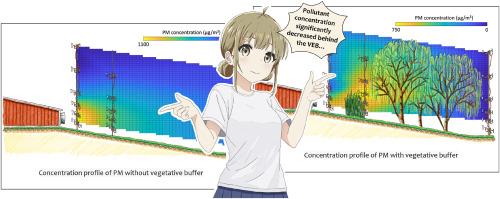Assessment of the net mitigation effect of vegetative environmental buffer (VEB) to reduce ammonia and particulate matter (PM) emissions
IF 3.7
2区 环境科学与生态学
Q2 ENVIRONMENTAL SCIENCES
引用次数: 0
Abstract
Concentrated animal feeding operations (CAFOs), such as poultry farms, contribute significantly to air pollution, particularly ammonia (NH3) and particulate matter (PM) emissions. Vegetative environmental buffers (VEBs) offer a sustainable, cost-effective, and low-maintenance solution for mitigating NH3 and PM emissions from CAFOs, and some previous studies showed that pollutant concentrations behind the VEBs were substantially reduced compared with concentration directly from the source. However, due to the lack of a controlled dataset for non-VEB situations, the net effect of VEBs could hardly be assessed. Thus, the dataset from the previous study was used to develop a methodology for quantitatively evaluating the efficacy of VEBs in reducing NH3 and PM emissions from a poultry house, and to distinguish the net pollutant reduction achieved by VEBs from those resulting merely from atmospheric dilution and dispersion. The results showed that VEB can effectively mitigate air pollutants emissions and attributes enhanced ground-level reductions of NH3 (72.7 % ± 9.1 %), total suspended particle (TSP) (61.9 % ± 10.0 %), PM10 (62.5 % ± 9.9 %) and PM2.5 (94.6 % ± 6.5 %). In addition, VEB demonstrated better mitigation performance during daytime. Meteorological conditions showed no correlation with pollutant concentrations or enhanced reduction ratios while significant positive correlations between reductions of NH3 and PM were also observed. These results demonstrated that VEBs are effective in reducing NH3 and PM emissions from poultry houses. The results from this study will inform conservation practice guidelines and assist land managers in employing VEBs for poultry house emitted air pollution reductions.

评估植被环境缓冲带(VEB)对减少氨和颗粒物(PM)排放的净缓解效应
集中的动物饲养作业(cafo),如家禽养殖场,严重造成空气污染,特别是氨(NH3)和颗粒物(PM)的排放。植被环境缓冲带(VEBs)为减少cafo的NH3和PM排放提供了一种可持续、经济、低维护的解决方案,以前的一些研究表明,与直接来自污染源的浓度相比,VEBs后面的污染物浓度大大降低。然而,由于缺乏非veb情况的受控数据集,很难评估veb的净效应。因此,研究人员利用先前研究的数据集开发了一种方法,用于定量评估veb减少鸡舍NH3和PM排放的有效性,并将veb实现的净污染物减少与仅通过大气稀释和分散实现的净污染物减少区分开来。结果表明,VEB能有效减缓大气污染物的排放,并能促进地面NH3(72.7%±9.1%)、总悬浮粒子(TSP)(61.9%±10.0%)、PM10(62.5%±9.9%)和PM2.5(94.6%±6.5%)的减少。此外,VEB在白天表现出更好的缓解性能。气象条件与污染物浓度或减少率的增加没有相关性,而NH3和PM的减少之间也存在显著的正相关。上述结果表明,VEBs可有效降低鸡舍NH3和PM的排放。这项研究的结果将为保护实践指南提供信息,并协助土地管理者采用veb来减少禽舍排放的空气污染。
本文章由计算机程序翻译,如有差异,请以英文原文为准。
求助全文
约1分钟内获得全文
求助全文
来源期刊

Atmospheric Environment
环境科学-环境科学
CiteScore
9.40
自引率
8.00%
发文量
458
审稿时长
53 days
期刊介绍:
Atmospheric Environment has an open access mirror journal Atmospheric Environment: X, sharing the same aims and scope, editorial team, submission system and rigorous peer review.
Atmospheric Environment is the international journal for scientists in different disciplines related to atmospheric composition and its impacts. The journal publishes scientific articles with atmospheric relevance of emissions and depositions of gaseous and particulate compounds, chemical processes and physical effects in the atmosphere, as well as impacts of the changing atmospheric composition on human health, air quality, climate change, and ecosystems.
 求助内容:
求助内容: 应助结果提醒方式:
应助结果提醒方式:


